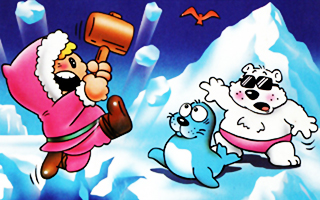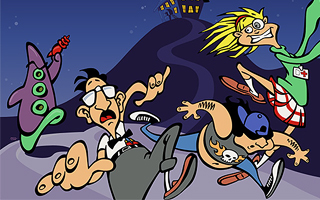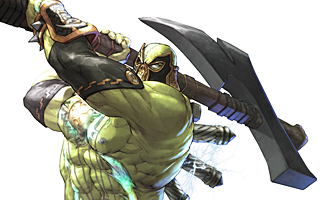Game Changers of the 2000s
Top 10 Most Important Video Games of the 2000s!
This list looks at the most important video games released between 2000 and 2009. The first decade of the 21st century challenged our preconceived notions of what it meant to be a gamer. Arcades were dying and the number of viable console manufacturers had been whittled down to three, but there were more people playing games than ever before. The rise of the Internet and the introduction of smart phones challenged the way we look at video games, and everyone was looking for a way to reel in the new casual audience. The games on this list aren’t the best games from the decade, and they’re not necessarily the most creative either. For better or for worse, they were all disruptive forces within the gaming industry. Whether they changed how games are played or they changed who they were played by, the ten titles on this list left an indelible mark in the gaming sphere.
10
Guitar Hero
2005

PaRappa the Rapper helped popularize the concept of rhythm games in 1996, and Konami’s beatmania brought the genre to the next level in 1998 with its unique turntable controls. GuitarFreaks was the next step in the evolution chain, and it allowed users to play licensed songs on a special guitar-shaped controller. GuitarFreaks didn’t have much exposure outside of Japan, however, so RedOctane and Harmonix stepped in and filled the void with their own guitar game. At launch, Guitar Hero featured 30 popular songs spanning five decades of rock music. The tracklist was an eclectic mix that covered a wide range of different eras, and this made the game appeal to a wide demographic. Unlike GuitarFreaks, Guitar Hero featured full-length songs, and this allowed for a more authentic rockstar experience. Its guitar peripheral also had five fret buttons instead of three, and this only contributed to its authenticity. The importance of GuitarFreaks should not be underplayed, but Guitar Hero took the concept and turned it into a cultural phenomenon. The series peaked with the release of Guitar Hero III, and you couldn’t go to a house party in the mid 2000s without someone busting out plastic guitars. After acquiring RedOctane in 2007, Activision flooded the market with spinoffs and sequels. (In 2009, there were over 20 separate Guitar Hero SKUs on store shelves!) The industry milked the cash cow until it was dead, but it was a fun ride while it lasted.
9
FarmVille
2009

In a cynical bid to attract advertisers and generate positive PR, industry reps often claim that half of gamers are female. These statistics help illustrate how gaming is now a mainstream activity, but the data is misleading since participation rates vary drastically from one genre to the next. The female participation rate for first-person shooters is less than 10%, for instance, and the audience for sports games is only 2% female. There are a couple of genres where women drastically outnumber men, however. Females tend to gravitate to casual match-three puzzle games like Candy Crush Saga and free-to-play social network games like FarmVille. Released by Zynga in 2009, FarmVille revolves around tasks like plowing land, harvesting crops, planting trees, raising livestock, and performing other tedious chores. When you weren’t bogged down with mundane tasks, you were likely being inundated with vapid ads for McDonalds or Lady Gaga. FarmVille required an unprecedented commitment from the player, and the only reason it was successful was because of its social networking aspects. In order to improve their farms, players were encouraged to spam their Facebook friends with FarmVille requests. If you didn’t want to annoy your friends, you could simply purchase “Farm Cash” with real-world currency. The entire game was built around a model of exploitation, but it was a perfect fit for the social media audience. FarmVille was the most popular game on Facebook after its launch, and it had over 83 million active users at its peak in 2010. It’s a good thing exploitative business practices are confined to social media games, right?
8
League of Legends
2009

Multiplayer online battle arena (MOBA) games could be described as a fusion of action games and real-time strategy games. The roots of the sub-genre can be traced as far back as Herzog Zwei on the Sega Genesis, and Future Cop: LAPD became the first to implement online play in 1998. That same year, a custom StarCraft map called Aeon of Strife introduced the concept to the masses. This map later inspired the Defense of the Ancients mod for Warcraft III, and the modern-day MOBA was born. League of Legends was conceived as a spiritual successor to DotA, but it expanded the number of heroes and introduced a new progression system. DotA was tethered to Warcraft III, but League of Legends allowed for official matchmaking. By offering a game free of hackers, griefers, and lopsided matches, Riot Games jumped into a market that was largely untapped. League of Legends is a free-to-play game that’s supported by micro-transactions, and this pricing model all-but-guaranteed that it would have a healthy user base right out of the gate. The game was well-received upon its release in 2009, and its popularity only continued to grow in the years that followed. It had 67 million active monthly players at its peak, and it has one of the hottest competitive scenes in gaming. The 2017 World Championship had 60 million unique viewers, for instance, and the Riot Games’ Twitch channel was the first to pass one billion views. A decade after its release, League of Legends is routinely one of the most-played (and most-viewed) games on the planet.
7
Halo: Combat Evolved
2001

When Bungie unveiled Halo at the 1999 Macworld conference, it was a sign that Apple was finally going to take gaming seriously. A year later, Microsoft acquired Bungie and positioned Halo as the killer app for their upcoming Xbox console. The Xbox was slated to be significantly more powerful than rival consoles, but Microsoft needed a high-profile exclusive to compete with the established brands that Nintendo and Sony had created. An ambitious military first-person shooter set against the backdrop of a science fiction universe was perfectly-suited for the audience that Microsoft was trying to reach. The PC market had been dominated by the FPS genre for the better part of a decade and games like GoldenEye were starting to dominate the console space, so Microsoft’s decision to promote Halo as their flagship title helped define the entire Xbox brand. The Xbox was aimed at an older demographic than the PS2 or GameCube, and the “dudebro” audience informed the direction of the company in the years that followed. Halo picked up numerous “Game of the Year” awards and had many subtle innovations, but it wasn’t especially revolutionary. It deserves tremendous credit for establishing Microsoft as a serious player in the industry, however. The success of the Xbox can largely be attributed to Halo, and the game’s focus on multiplayer modes can be seen as a precursor to Xbox Live. No game better exemplifies the Mountain Dew era of gaming than Halo.
6
Bejeweled
2001

Gamers have a tendency to underplay the importance of casual audiences, so titles like Bejeweled don’t always get the recognition they deserve. Bejeweled was developed for web browsers in 2001, and it introduced the masses to what would later be known to as “match three” games. The purpose of the game was to a swap tiles around on a grid in an effort to line up (at least) three gems of the same color. Bejeweled drew heavy inspiration from a Russian puzzle game called Shariki, and similar play mechanics were used in games like Tetris Attack and Pokémon Puzzle League. Bejeweled reached a much larger audience than any of its contemporaries, however. PopCap Games established partnerships which allowed Microsoft Zone and other gaming sites to host the game for free, and this gave the game unprecedented levels of exposure. From 1999 to 2001, the number of households that used the Internet around the globe had effectively doubled. Services like MSN Messenger grew exponentially during this time period, and they provided millions of people with a new form of communication. The casual nature of Bejweled made it a perfect game to play while chatting with your friends on MSN. It was simple enough for anyone to understand, and you could play the game for a few minutes at a time and still have fun with it. The game was downloaded more than 150 million times by 2008, and 70% of its users were above the age of 30. Adult women comprised the largest demographic, and the game challenged pre-conceived notions about the industry’s potential to appeal to the mainstream. For better or worse, Bejweled can be viewed as a precursor to social media games and mobile apps like Candy Crush Saga.
5
The Sims
2000

The Sims was an aptly-named game from Maxis that simulated the daily activities of virtual people (called “Sims”) in a suburban household. The Sims were influenced by their interactions with various objects and other sims, and their behavior was largely autonomous. Players had to interject from time to time to ensure that their Sims would be able to pay bills, find employment, or conceive children. Daily needs like hygiene and eating had to be scheduled too, and the Sims would suffer the consequences if these needs were neglected. The Sims would literally starve to death without human intervention, and bathroom accidents were more common than you’d imagine. As you guide your Sims through the daily grind, you are given considerable control over how their lives unfold. There are no victory conditions, however, so you are free to experiment with your Sims in any way you see fit. The game’s open-ended nature is reminiscent of SimCity, and Will Wright began working on the project shortly after the release of SimAnt. I, for one, welcomed our new ant overlords, but focus groups were more critical. Incidentally, the virtual doll houses from The Sims were a lot more relatable than virtual ant colonies. By 2003, The Sims had become the best-selling PC game in history. It was especially popular with casual gamers, and 60% of its users were female. The success of the game sent shockwaves through the industry, and it encouraged many publishers to focus on demographics that had traditionally been overlooked.
4
Wii Sports
2006

The GameCube was an impressive piece of hardware that was more capable than the PlayStation 2 in most regards, but sales lagged far behind Sony’s console. After finishing the generation in third place, Nintendo decided to take the industry in a radical new direction with their next console. While Sony and Microsoft were readying a new generation of consoles that would take advantage of high-definition televisions, Nintendo wanted to focus on a new form of player interaction. In order to get new people playing games, Nintendo created a new controller that emphasized motion. Wii Sports was the perfect game to showcase this technology. The game featured five different sports – tennis, baseball, bowling, golf, and boxing – and the play mechanics were built around gestures that players were already familiar with. Buttons and analogue sticks were too confusing for some players, but everyone could swing the Wii Remote like a golf club or a tennis racket. The built-in familiarity made the game appeal to people who would not otherwise be interested in video games, and its accessibility helped attract swaths of casual gamers. The Wii went on to sell five times as many units as the GameCube, and Wii Sports contributed to the console’s success in a meaningful way. With over 80 million Wii Sports discs in circulation, the game sold twice as many copies as Super Mario Bros. did. With all due respect to John Madden Football, Wii Sports was the most important sports game since Pong.
3
Angry Birds
2009

Some of you are probably growing tired of all the “casual shit” on this list, but mobile games make up more than 50% of the global gaming market. The release of Angry Birds coincided with the rise of smart devices, and it was one of the first runaway hits on the iPhone. There were many reasons why it was a success. In the game, players launch birds with a slingshot in order to destroy evil pigs and knock down various structures. The concept was simple enough for anyone to understand, the slingshot mechanics were a perfect fit for touchscreens, and its aggressive pricing model encouraged millions of customers to buy it on impulse. The game cost a mere $1.99 when at launched for iOS in December of 2009, and it shot to the top of App Store charts almost immediately. Over 12 million users have downloaded the game to date, and more the two billion people have played the game across all platforms. The free in-browser version of the game accounted for many of the players, but Rovio Entertainment leveraged its user base into a viable franchise. The game has spawned countless spinoffs, and Angry Birds merchandise is everywhere. (The brand has inspired everything from feature films to amusement park attractions!) Angry Birds wasn’t especially innovative, and it lifted many of its ideas from a free Flash game called Crush the Castle. If nothing else, the game’s success illustrates the importance of marketing, cross-promotion, and App Store optimization. When it comes to mobile gaming, visibility is more important than ingenuity, and Angry Birds was one of the first games to illustrate this point.
2
Grand Theft Auto III
2001

Grand Theft Auto III is a third-person action-adventure game that changed the entire industry. Players progress through the game by completing linear objectives, but they are given tremendous freedom to roam the open world of Liberty City between missions. Whether you were stealing vehicles, robbing banks, or running from the cops, there was no shortage of things to do. The game rewarded creativity, and players were encouraged to try new things. You could rig vehicles to explode, hijack police helicopters, take on paramedic missions after stealing ambulances, or blow up your enemies with RC cars. The game featured over 80 vehicles – ranging from sports cars to dump trucks – and it was tremendous fun to drive around aimlessly. You could ramp up the excitement at any time by performing impromptu stunts, or you could simply sit back and listen to one of the game’s nine radio stations. You could also stroll for hookers whenever you needed to replenish your health. The game dealt with mature themes like drugs, violence, and prostitution, but it never took itself too seriously. The dark sense of humor wasn’t for everyone, of course, and the game was heavily criticized by authoritarian politicians and media figures alike. Ultimately, the controversy only served to make the game more popular. Today, the game is fondly remembered for the unprecedented level of freedom that it granted. With Grand Theft Auto III, Rockstar Games gave us an immersive sandbox to play in, and they changed the way that games are made.
1
World of Warcraft
2004

Massively multiplayer online role-playing games (MMORPGs) date back to the early 1990s, and their roots can be traced as far back as the mid ’70s. World of Warcraft is easily the most successful game in its category, however. Its player base approached ten million in 2009, and there were over a hundred million registered accounts by 2014. Seven major expansions landed after its initial release, and Blizzard Entertainment deserves credit for its ongoing support of the game. To date, the title has grossed nearly ten billion dollars in revenue! There are many factors that contributed to the success World of Warcraft. The Warcraft series had amassed a loyal fanbase in the 1990s, so the game had a high level of interest from the moment it was announced. There was a three-year period of high anticipation before its eventual launch, and this ensured that the game would have a sizable user base from day one. Expectations were high, but the game didn’t disappoint. There were a wide range of quests in each location, the various character classes were viable and interesting, and each race had a distinct look and feel. The environments were also breathtaking, and each area looked different from the next. The most important components of any MMORGP are its social elements, and World of Warcraft took several approaches to ensure that the game would be as welcoming as possible. You could quickly return to combat after being injured, for instance, and there were ways for new players to quickly catch up with their friends in progression. The pacing of the game made it more accessible to casual players than typical MMORPGs, and this contributed to its ongoing success. On a personal note, I’ve had multiple friends who have met their future wives while playing World of Warcraft. If that’s not the mark of a successful game, then I don’t know what is.





Do you agree with this list? Let us know what you think by leaving a comment below. Your opinion matters!